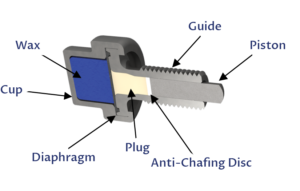Thermostatic Solutions for Temperature Control Applications
The wax-filled thermostatic element was invented in 1936 by Sergius Vernet (1899-1968). Its principal application was in automotive thermostats used in the engine cooling system. Wax thermostatic elements transform heat energy into mechanical energy using the thermal expansion of waxes when they melt. In addition to engine cooling systems, this wax motor principle also finds applications in heating system thermostatic radiator valves, plumbing, industrial, and agriculture.
Today, this technology is widely used across a broad spectrum of industries including aerospace & defense, most often for temperature control of various fluid systems.
Thermostatic Actuators
The operation of a wax-filled thermostatic actuator is based on the principle that there is a significant change in the volume of paraffin wax as it goes through a phase change from liquid-to-solid; solid-to-liquid as the wax temperature increases and decreases.
The volume change is transduced into a linear, repeatable mechanical motion. Due to the non-compressible nature of the wax, this motion can also produce a significant amount of force. It has a very high-power density.
The basic elements of a thermostatic actuator include:
- Wax – motion-producing element.
- Cup – contains the wax and other key compounds.
- Diaphragm – seals in the wax and creates motion during expansion.
- Guide – retains the Diaphragm creating a seal while guiding the Plug and Piston.
- Plug – transmits and amplifies the wax expansion via the Diaphragm increasing stroke.
- Anti-Chafing Disc – prevents the Plug from extruding around Piston when force is applied.
- Piston – transmits the Plug’s movement into useable stroke.
How the Technology Works
The Thermoloid® wax material that makes all of ThermOmegaTech® thermostatic valves operate is sealed inside the actuator, and as temperature increases above the melting point of the material, it expands in volume and pushes against a diaphragm, which in turn pushes on a piston. The piston acts as a valve stem, opening or closing a valve or other mechanical device. As the material cools below its melting point, its volume decreases and a spring or some other external applied force returns the piston and diaphragm to the “cold position”. The phase change, and resulting large volume change, produce motion over a narrow and highly predictable temperature range, and the temperature range at which the phase change occurs can be varied depending on the chemical composition of the Thermoloid® material that is used…
To check out the full article visit Aerospace & Defense Technology.
October 1, 2018
